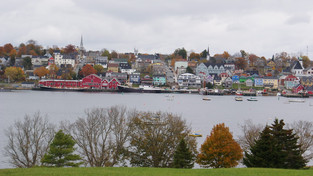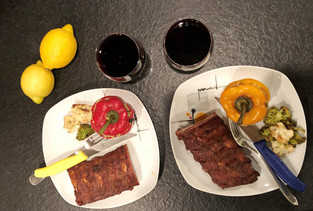On the eastern tip of Canada lies the province of Nova Scotia. This touristic gem of Canada is less known among the Europeans, although it is second-most densely populated province and the most populous of Canada’s three Maritime provinces and four Atlantic provinces.

Nova Scotia offers beautiful culture, stunning scenery and gorgeous coastline, boasts many heritage museums and music festivals, has 87 national historic sites and is the first certified UNESCO Starlight Tourist Destination. In our new project on gastronomic memories and stories told by friends worldwide, we start with Nova Scotia’s bright-smiling foodie Nora Didkowsky who is telling us about her childhood in Nova Scotia, province’s gastronomy, family heritage, and new life in Swiss Alps!
Nora, you are born in Nova Scotia, in a rural setting. Most Europeans envision Canada as a country with vast open and cold spaces. How would you describe the feeling of Nova Scotia in that sense?

Much of Nova Scotia is rural, with rolling hills, dense forests, coastal communities and farm land. As a peninsula, we are almost completely surrounded by the sea. Because of our proximity to the ocean, even during the hottest summer days there is a nice breeze. Our temperatures can sometimes get as low as -30 in the winter and + 30 or more in the summer.

When you get into the rural areas, the night skies are stunning and if you are lucky, you can even see the Northern lights. Our shoreline is quite spectacular - in some places windswept, wild and jagged, and in other places, you’ll find smooth, white sand beaches. I think the province has a special feel and smell - salt water on the breeze closer to the shore, the smell of wafting wild roses, cut grass, and pines more inland. The people are really what makes Nova Scotia feel warm and welcoming. People are friendly, down to earth, like a good laugh, and it isn’t uncommon for tourists to be invited to a kitchen party, or to be welcomed into someone’s home for a cup of tea and a good story. The general pace of life in Nova Scotia, even in the city, is relaxed.
Like most people in Canada, your background is varied. Still, your grandma is a special story. She came from Slovakia, had spectacular life stories, you call her babushka, and you’ve experienced a very Slavic gastronomy background. What did she cook for you when you were little and can you describe the table culture in your home?

Both of my grandmothers were a huge influence in my life. They were both fiery souls who taught me so much about keeping a sense of humour, the value of hard work, and resilience. On my Dad’s side, Babushka was an incredible cook. She would never waste a thing. She was a mushroom encyclopedia and loved to get into the bush to pick edible plants. We couldn’t wait to eat anything Babushka cooked for us. My favorites were ushki, piroshki, Hungarian paprikash, blinchikis, borscht, and sigiliski goulash. Babushka had a strong religious faith, so table culture at her house meant starting with prayer before filling our stomachs.

On my Mom’s side, my Grandma and her family were of Scottish heritage. I still remember that my great great uncles would wear kilts as their everyday clothes. Grandma made the best apple pies, butter tarts, homemade bread, baked beans, stuffed turkey, and biscuits. We are a very large family. Up to 40 of us would and still do get together to cook, play music, dance and eat. Before dinner, always happy hour with a few drinks, and then after dinner, always tea, dessert and more singing. At every meal we go around the table and give thanks, and say what the best part of our day was. We still do this.
Folks in Nova Scotia are crazy for lobster. You have so many lobster dishes and even lobster beer! Additionally, you have a plethora of sea dishes which is understandable because Nova Scotia is so open to the Atlantic Ocean. The largest scallop fishing fleet is located in Digby, and there are variety of ways how the Digby scallops are prepared. In the Bay of Fundy people harvest edible red seaweed that becomes a popular snack. And the Seafood trail in Nova Scotia cannot be traversed without Oyster Trail, which might be one of the most recognisable tastes of the region. Are you a seafood fan and can you tell us more about Nova Scotia’s love with the sea?

I can’t get enough of Nova Scotia’s seafood, which to me tastes the freshest and best of any the world over. I also eat a lot of freshwater and saltwater fish. Even though we are a small province, our coastline spans 7,400 kilometers, we have over 130 rivers, 6700 lakes, and no community in the province is more than 60 kilometres from the ocean. A lot of my favourite comfort foods are seafood based – seafood chowder, muscles in white wine or on the barbeque, lobster cooked on the beach, Digby scallops (you really did your research!). A family friend grows fresh scallops in Chester called Baytender Scallops. I just learned that some fishermen will use the heat from their muffler on their vehicles to quickly cook scallops!

I think as any Maritime location knows, the sea provides, but the sea also takes away. What I mean is, our livlihoods in rural Nova Scotia are largely shaped by fishing, forestry and farming. This kind of work can be difficult and dangerous. Salt water is in our bones, but we also have immense respect for the power of the ocean. There are around 25,000 ship wrecks that lie under the waters off of our rocky coast. You can go diving to explore them. That is why Nova Scotia has so many working lighthouses – about 150, our most famous being Peggy’s Cove Lighthouse.

I grew up in Hants County along the red-mud Bay of Fundy, where we have the highest tides in the world. At Burntcoat Head, tides average 55.8 ft (17.0 m), and can get as high as 70.9 ft (21.6 m). 160 billion tonnes of water rush in and out of the Bay, twice a day. When the tide is coming in, you can tidal bore raft on the rapids. When the tide is out, you can walk on the ocean floor. There are companies which will cook you a 5-course, 5-star meal or lobster dinner, paired with delicious local wines or beer, all to be enjoyed at the same spot as the highest tides, on the ocean floor. It’s pretty special.
Though seafood is more traditional fare here, we also have a lot of great restaurants serving everything from Italian, Greek, Turkish and Mediterranean, to Thai, Ethiopian, and Mongolian. What I really like to see are all of the incredible vegetarian and vegan restaurants getting a strong following. There really is something for everyone.
Not only seafood, but fruits are also well known in your region. Oxford is known as Canada’s wild blueberry capital, and Annapolis Valley is famous for its apples. What the Nova Scotia’s culinary tradition does with fruits, and what are you favourite Canadian fruit?

In my area, wild blueberries, blackberries, raspberries, strawberries, and apples are plentiful. We make a lot of jellies and jams, and pies of course. My favourite ways to cook with our fruits are crumbles and crisps - you need to try blueberry crisp. Also, the best desserts in the spring are strawberry shortcake and rhubarb and strawberry crisp. People also like to make homemade wine with our fruit, which is delicious but dangerous (in a good way)! Also, we can’t forget another delicious product coming from a tree that our province is known for – maple syrup!

We also like to celebrate our fruit! For example, each spring there is an Apple Blossom Festival in the Valley, with food tasting, lives bands and parades. In fact, we like to celebrate a lot. There are over 750 events and festivals each year showcasing our food, music and history. Some other food celebrations to check out would be Rotary Club of Halifax Harbourside’s Ribfest, Digby Scallop Days, the Blueberry Festival, any of the many international food festivals, and in the spring, the Maple Syrup festivals. You can take a horse-drawn sleigh ride to see the tapped trees, and then eat maple syrup candy (maples syrup poured onto snow and then eaten).

Our province has a really vibrant food and music scene. Community-supported agriculture initiatives are happening across the province, and local markets with fresh local produce are abundant. I grew up on a small family farm (Birch Burn Farm) so we learned about planting, weeding, harvesting, and preserving food by doing it together as a family. Recently, a family friend has started a community supported agriculture initiative, using our fields as her home-base. Each of my family members contributes to the modest venture. It is an organic farming and distribution model that connects the producer and consumer more closely, while strengthening community connections, bolstering rural food security, supporting local markets, and preserving biodiversity in agriculture.
If any food would be a signature dish of Nova Scotia, most Canadians would point to the Donair. It is official food of region’s capital, Halifax. Spiced beef, cooked on a spit and shaved onto a pita, doused in a sweet garlic sauce and garnished with tomatoes and raw onions, Donair has its own cult in Halifax. At the same time, you say it is your least favourite food. Why is that and can you describe more about people’s love for Donair?

It is not a stretch to say that a lot of Nova Scotians love Donairs. It is a favourite late night, after-bar, ‘get rid of your hangover’ food. It really has its origins in Greece, but the key Halifax innovation is the spice and the sweet garlicky sauce. I love all of the other elements of the Donair, but the Donair sauce is too sweet for me. But it's no longer a bonafide Halifax Donair without the sweet sauce. And most people love it. So I think you will need to try one for yourself to see.
Good Cheer Trail would probably be the first to explore among culinary trails in Nova Scotia! Distilleries, breweries, cideries, but also wineries are famous representatives of long traditions. Some 30 per cent of population have origins from Scotland, so it is understandable to have good whiskeys! But wine, so far north? This deep history dates back to the 1600s with the Annapolis Valley, one of the first areas in North America to cultivate grapes for wine. Tidal Bay is, obviously, a must! Which drinks should we drink when we look in your Nova Scotia’s cupboard?

Yes, we have great whiskeys, delicious ciders are produced from our plentiful apple orchards, and we even have great vodkas. Definitely some of the best places to get excellent wines are in the Gaspereau and Annapolis Valleys, which are worth the drive just for the beautiful scenery. Tidal Bay is Nova Scotia’s signature wine, and Grand Pre Wineries makes a delicious one. I understand that their Ortega and Pomme D’Or Apple Cream are also tasty. An interesting wine made in Nova Scotia is rhubarb wine. I haven’t seen that anywhere else. Perhaps because Nova Scotia has a history of pirates using our shores and islands to hide their loot, a lot of people here love a good rum and coke.

Ironworks in Lunenburg Nova Scotia make a rum called Bluenose Rum. Nova Scotians are called ‘Bluenosers’, either because of planting blue potatoes, or because of the marks that were left on fishermen’s noses from their blue mitts. On Canada’s 10 cent coin is an image of The Bluenose, a celebrated fishing and racing vessel named after Nova Scotians and built in Nova Scotia in 1921. If you like hiking and biking, we have a 110 km ‘Rum Runners’ trail that takes you through coastal communities to seafaring and old rum-running sites.

The best gin I’ve ever tasted is also from Ironworks in Lunenburg, Nova Scotia. I make sure to bring a bottle back to Switzerland each trip, and always ask family to bring me some when they come. It is made with Nova Scotia wild juniper berries that grow along the barrens of the Atlantic coastline, hand-picked local rose hips and a light infusion of balsam fir bud eau de vie. It is amazing.

And you can’t come to Nova Scotia without tasting our beers. Alexander Keith’s is probably our best known beer, but we also have a huge craft beer scene. There are at least 50 craft breweries across the province making different styles of beer with local ingredients. Garrison Brewery’s Nit Wit, a Belgian style wheat beer, was created by my cousin, who won the 2010 Garrison’s Ultimate Brew-off competition. My husband really likes the special ‘forest’ taste of Garrison’s Spruce beer. My cousin really likes the Luxury beer from Church Brewing. There are so many good beer crafters right now. A number of my friends own craft beer operations across Nova Scotia, such as Lunn’s Mill Beer Co and Saltbox Brewing Company in Mahone Bay. Both have a tap room where you can try different beers and ciders, and both hold community events. Saltbox Brewing for example, hosts dory racing events, and Lunn’s Mill Beer Co. have music nights.
You live now in Switzerland. In midst of Swiss Alps, happily married to a Swiss guy, what changed in your kitchen? Do you still cook Canadian foods? How did you adjust to Swiss cuisine and which dishes would you single out?

I definitely eat and cook with a lot more cheese now! Switzerland has amazing cheeses. Almost every traditional dish here involves cheese or potatoes, and most dishes are quite rich. Of course raclette (bubbling, melted cheese on roasted new potatoes), fondue, and rosti (potato pancake) are musts. I happily have a husband who is a great cook. I love the cooking culture we have created together, which usually involves enjoying a good Swiss wine, preparing food while playing chess or dancing in the kitchen, and experimenting with tastes.

We travel a lot and bring back different spices to experiment with. We source a lot of what we use locally, grow it ourselves, or find it in the forest. In the fall we spend a lot of time looking for wild mushrooms, like steinpilz (boletes) and chanterelles. When we eat meat, it is usually wild. Stefan, his parents and I make our own sausages and dried meats. Some amazing traditional wild meat dishes to try are gemse (wild goat) or reh (a small deer) pfeffer. Preparing those dishes takes a lot of care. The meat is soaked in herbs, spices, red wine and vinegar for two weeks. Then the meat is dried, coated with flour, then fried until very dark on all sides. Then a special sauce is made from the brine it was soaked in, and the whole thing is cooked again until thick. It leaves the meat so tender. Traditionally you enjoy it with spatzli (hand-made egg noodle), red cabbage, and glazed chestnuts. Oh!
Another traditional Swiss dish that I love are their green beans, which are dehydrated, then rehydrated in bouillon, then cooked with fried onions, garlic and white wine. By the way, Swiss wines are some of the best I have ever tasted. I still cook traditional Nova Scotian foods, or we mix Nova Scotian fare with something traditionally Swiss for fun, but I do miss the fresh sea food. When we travel to Nova Scotia, we always bring back seafood so we can cook it here. Basically now I feel like I have the best of both cooking worlds.
For anyone who enjoys hiking, meaningful cultural experiences and wants to try (and even learn how to cook) some wonderful traditional Swiss meals, I would recommend joining us for one of my Mother’s Switzerland hiking tours in Kandersteg. Her company is called Spirit Adventure tours and each summer we create special Swiss culinary experiences for guests. For example, past guests have stayed in a traditional farmhouse owned by Swiss mountaineer, Elisabeth Nagel-Hari. She just had her 90th birthday, and she still takes time every summer to teach guests how to cook traditional dishes like rosti.
All photos taken by Nora Didkowsky, or her family members and friends, with exception of Donair Photo, taken from Nova Scotia Tourist Board
































































































Comments